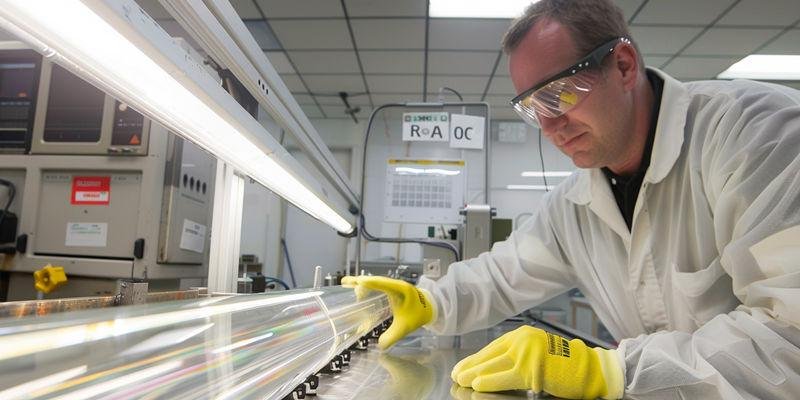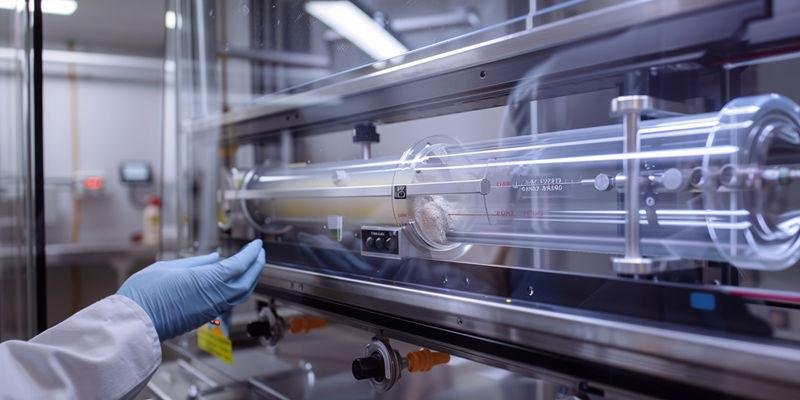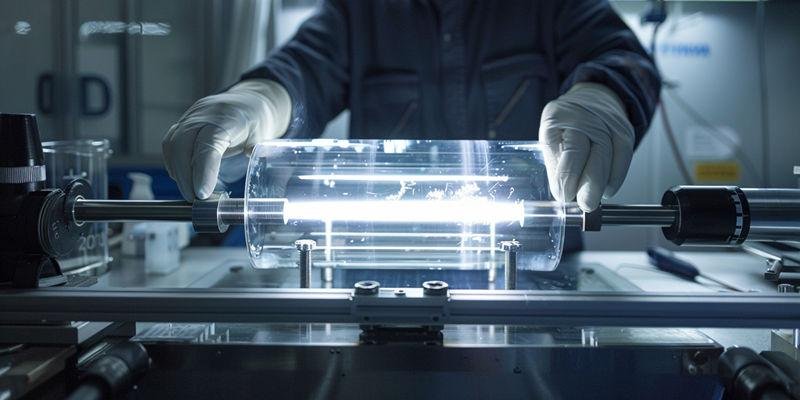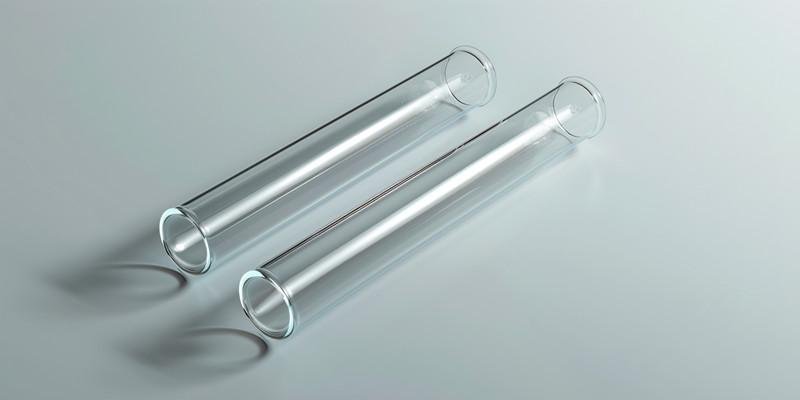
Quartz tube applications industrial uses span lamp manufacturing, semiconductor processing, photovoltaic production, chemical processing, and laboratory equipment. Each industrial application relies on the unique properties of clear fused quartz tube, such as high-purity silica composition, resistance to extreme temperature, and chemical durability. The following table highlights the key industrial uses and the reasons fused quartz tubing meets strict technical demands:
التطبيق | الوصف |
|---|---|
Lamp Applications | Used in UV and halogen lamps for high temperature and UV resistance. |
أشباه الموصلات | Critical for wafer processing and CVD in high-precision manufacturing. |
Photovoltaic | Utilized in solar cell production, especially for high-temperature steps. |
Others | Includes chemical processing and laboratory instruments needing high-purity materials. |
Quartz features thermal stability above 1,000°C, chemical inertness, mechanical strength, and thermal shock resistance, making it ideal for demanding applications across various temperature ranges.
الوجبات الرئيسية
Fused quartz tubes excel in high-temperature applications, withstanding temperatures up to 1200°C, making them ideal for semiconductor and ceramic processing.
High-purity silica in quartz tubes prevents contamination, ensuring reliability in sensitive processes like semiconductor manufacturing and pharmaceuticals.
Quartz tubes transmit over 90% of UV light, making them essential for effective sterilization and UV curing processes in various industries.
The low thermal expansion of quartz minimizes the risk of cracking during rapid temperature changes, enhancing durability in demanding environments.
Engineers should prioritize purity, thermal resistance, and supplier quality when selecting quartz tubes to ensure optimal performance in industrial applications.
How Do High-Temperature Furnace Applications Utilize Quartz Tubes?
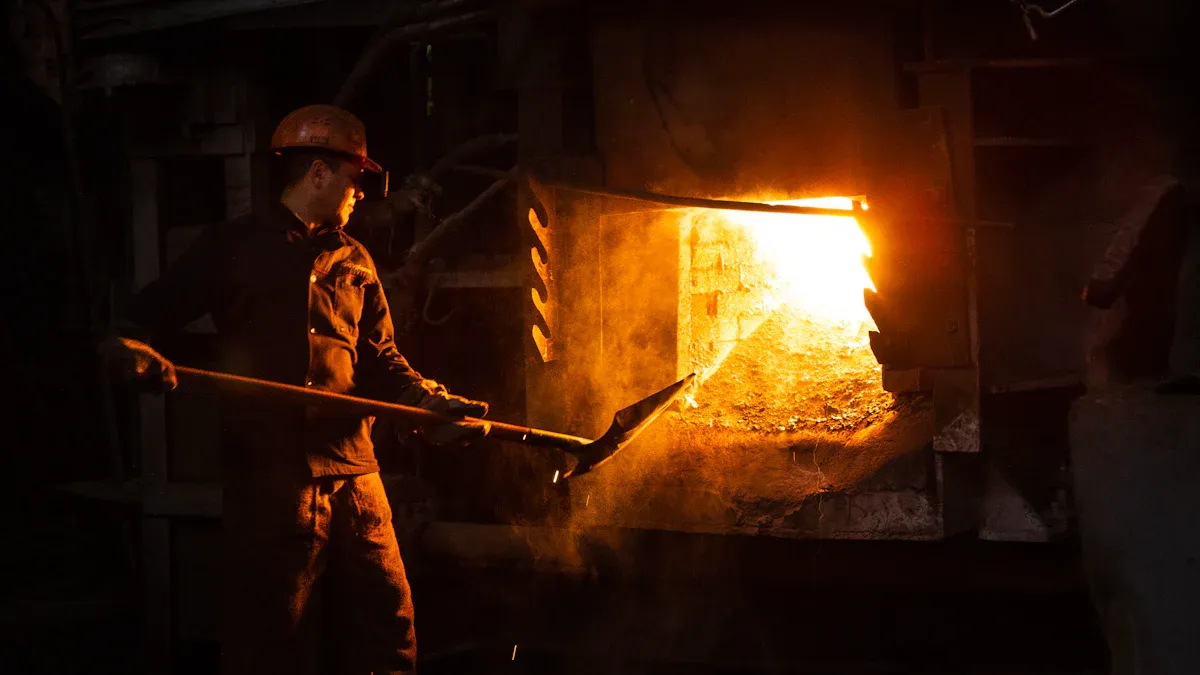
High-temperature furnace environments demand materials that can withstand extreme heat, rapid temperature changes, and exposure to reactive chemicals. Quartz tube applications industrial uses in these settings rely on the unique properties of clear fused quartz tube, such as high-purity silica composition and exceptional thermal shock resistance. The following sections explain how fused quartz tubing supports critical processes in semiconductor manufacturing, ceramic processing, and metal heat treatment.
CVD and Diffusion Process Requirements in Semiconductor Manufacturing
Semiconductor manufacturing depends on high-purity fused quartz tubes for ترسيب البخار الكيميائي (CVD) and diffusion processes. These tubes prevent contamination of silicon wafers, ensuring device reliability. Their use supports the production of advanced integrated circuits.
High-purity silica in quartz tubes reduces the risk of defects, which improves yield and reliability. The semiconductor industry values thermal shock resistance and chemical stability, as these properties allow repeated rapid cycling and uniform thin-film deposition. Surface smoothness also helps maintain clean gas flow and wafer suspension.
Quartz tube applications industrial uses in CVD chambers and diffusion furnaces highlight the importance of purity and performance.
النقاط الرئيسية:
نقاوة عالية prevents metal contamination.
مقاومة الصدمات الحرارية enables rapid cycling.
Chemical stability ensures process consistency.
Materials Sintering and Ceramic Processing Parameters
Ceramic processing and materials sintering require precise control of temperature and atmosphere. Fused quartz tubing can operate at temperatures up to 1,200°C in standard furnaces, with sintering often occurring between 1,200°C and 1,350°C. These conditions promote densification and uniformity in ceramic products.
Low thermal expansion in quartz minimizes stress and cracking during heating and cooling cycles. This property allows manufacturers to achieve high-quality results in demanding applications. Controlled environments, such as vacuum or inert gas, further enhance process outcomes.
المواد | Volume Expansion (liters) |
|---|---|
الفولاذ المقاوم للصدأ | 28 |
زجاج البورسليكات | 5 |
كوارتز مصهور | <1 |
This table shows that fused quartz’s low expansion directly reduces the risk of thermal failure, making it ideal for ceramic processing.
Metal Heat Treatment Under Controlled Atmospheres
Metal heat treatment processes use quartz tubes to create stable, controlled environments for annealing and other thermal treatments. These tubes withstand temperatures from 1,100°C to 1,450°C, supporting a wide temperature range for different metals. In vacuum or inert atmospheres, quartz maintains its integrity and prevents unwanted reactions.
Manufacturers select quartz for its high melting point and resistance to rapid heating rates. The material’s durability ensures consistent results, even during repeated cycles. High purity fused quartz also prevents contamination during sensitive processes.
الملخص:
Wide temperature range supports various metals.
نقاوة عالية prevents contamination.
المتانة ensures long service life.
What Optical and UV Applications Require Quartz Tube Transparency?

Quartz tube transparency plays a vital role in many optical and UV applications. Industries rely on the unique optical clarity and high-purity silica composition of fused quartz tubing to achieve precise results. These applications span sterilization, curing, photochemical reactions, and high-intensity lighting.
Germicidal UV Lamp Design for Sterilization Systems
Germicidal UV lamps use clear fused quartz tube envelopes to deliver effective sterilization. The high melting point and excellent UV transmissivity of quartz enable these lamps to emit germicidal wavelengths that inactivate bacteria and viruses. This property ensures reliable performance in medical, water, and air purification systems.
Quartz tube applications industrial uses in sterilization systems depend on the ability to transmit UVC light efficiently. Other glass materials cannot match the UV transmittance and long-term clarity of fused quartz, making it indispensable for environments where consistent sterilization is critical. Typical lamp designs use tubes with diameters around 22 x 25 mm and wall thicknesses of 1.5 mm to optimize both strength and light output.
النقاط الرئيسية:
انتقال عالي للأشعة فوق البنفسجية ensures germicidal effectiveness.
الثبات الحراري supports continuous operation.
Long-term clarity maintains lamp performance.
UV Curing Process Optimization in Industrial Applications
UV curing processes in manufacturing require high-purity quartz tubes to maximize efficiency. These tubes transmit over 90% of ultraviolet light, which accelerates the curing of inks, coatings, and adhesives. Their chemical inertness prevents contamination, while high-temperature stability reduces maintenance and downtime.
Fused quartz tubing filters out unwanted infrared radiation, protecting substrates and system components from overheating. This controlled temperature environment is essential for applications that demand precise thermal conditions. The optical clarity of quartz supports rapid, uniform curing, improving throughput and product quality.
Manufacturers select quartz for UV curing because it combines chemical resistance, optical performance, and durability.
النقاط الرئيسية:
Over 90% UV transmission speeds up curing.
Chemical inertness prevents process contamination.
Temperature control protects sensitive materials.
Photochemical Reactor Configuration and Light Distribution
Photochemical reactors depend on the optical properties of fused quartz tubes to drive chemical reactions. These tubes provide excellent light transmission across the UV to IR spectrum, which enhances reaction efficiency. High resistance to thermal shock and chemical attack ensures durability and sample purity.
Consistent light access to reactive substances is crucial for effective photochemical processes. Fused quartz maintains this access even during prolonged operation, supporting uniform light distribution throughout the reactor. The ability to withstand continuous use at high temperatures, up to 1100°C, further increases reactor reliability.
الممتلكات | الوصف |
|---|---|
انتقال الضوء | >93% visible, >80% UV; boosts reaction efficiency |
الاستقرار الحراري | Continuous use up to 1100°C; supports reactor operation |
مقاومة المواد الكيميائية | Maintains sample purity; resists aggressive chemicals |
High-Intensity Lighting Envelope Requirements
High-intensity lighting systems, such as those used in stadiums and automotive headlights, require quartz tubes for their optical clarity and thermal stability. Fused quartz, with over 99% SiO2 content, endures temperatures up to 1400°C while maintaining structural integrity. The low coefficient of thermal expansion allows these tubes to resist temperature fluctuations and thermal shock.
Lighting applications benefit from the excellent transparency of quartz, which ensures efficient light transmission and consistent illumination. The durability of quartz extends the lifespan of lighting systems, reducing replacement frequency and maintenance costs. These properties make quartz the preferred material for demanding lighting environments.
الممتلكات | Value/Benefit |
|---|---|
معامل التمدد الحراري | 5.5 × 10⁻⁷ /°C; resists thermal stress |
Service Temperature | ≤ 1000°C continuous, up to 1200°C short-term |
الوضوح البصري | Ensures efficient light output and system longevity |
How Are Quartz Tubes Used in Chemical Processing and Corrosive Environments?
Quartz tube applications industrial uses extend into chemical processing and corrosive environments where durability and purity are essential. Engineers select clear fused quartz tube for its ability to withstand aggressive chemicals and maintain structural integrity at high temperature. These applications rely on the unique properties of fused quartz tubing to ensure safety, reliability, and compliance with strict industry standards.
Sight Glass and Level Gauge Applications in Aggressive Media
Sight glass and level gauge systems often operate in harsh chemical environments. Engineers must design these components to handle pressures higher than normal operation and account for potential overpressure events. They also follow safety standards such as API Standard 521 to prevent failures.
Designers consider several factors when specifying quartz for these applications. They assess the risk of impact damage, the corrosive nature of the process fluid, and the maximum temperature during process upsets. Proper engineering ensures the glass does not act as a pressure relief device and maintains safety even in extreme conditions.
Quartz provides a reliable solution for aggressive media due to its chemical resistance and mechanical strength.
العامل | الوصف |
|---|---|
Pressure | Must exceed normal and upset conditions to prevent burst failure |
Impact damage risk | Requires evaluation of both impact and corrosion from strengthening methods |
Process fluid | Corrosive fluids demand careful material selection to avoid galvanic corrosion |
Maximum process upset temp | Higher temperatures increase chemical activity and risk |
Normal service temperature | Use maximum upset temperature for specification if it persists |
Pharmaceutical Process Equipment Purity Requirements
Pharmaceutical manufacturing demands high-purity materials to prevent contamination. Fused quartz tubing meets these requirements by offering low contaminant and alkali levels, supporting the production of safe medicines. The high-purity silica structure ensures compliance with strict industry standards.
Quartz exhibits excellent thermal and optical properties, low thermal expansion, and high resistance to thermal shock. These features make it ideal for high-temperature pharmaceutical processes that require both durability and purity. Manufacturers trust quartz to maintain product quality and meet regulatory expectations.
High-purity fused quartz helps pharmaceutical companies achieve consistent results and protect patient safety.
النقاط الرئيسية:
Low contaminant levels support regulatory compliance.
مقاومة الصدمات الحرارية ensures durability in demanding processes.
سيليكا عالية النقاء maintains product integrity.
Long-Term Chemical Resistance Performance Data
Fused quartz demonstrates outstanding chemical resistance in industrial settings. It remains inert and stable when exposed to most acids, bases, and solvents, making it suitable for corrosive environments. Only hydrofluoric acid causes measurable reaction with quartz.
UV quartz tubes show virtually no reactivity to acids, even under high-temperature conditions. This stability ensures long service life and reduces maintenance needs in chemical processing plants. Operators rely on quartz for consistent performance over many years.
Quartz’s chemical resistance makes it a preferred choice for long-term use in harsh environments.
الممتلكات | النتيجة |
|---|---|
مقاومة المواد الكيميائية | Inert to most acids, bases, and solvents |
Reactivity | No measurable reaction except with hydrofluoric acid |
Service life | Long-term stability even at elevated temperatures |
Which Quality Standards Validate Quartz Tube Performance Across Applications?
Quality standards play a crucial role in ensuring that quartz tube applications industrial uses meet strict industry requirements. Engineers rely on these standards to verify that clear fused quartz tube products deliver consistent performance in demanding environments. The following sections explain how purity, dimensional accuracy, and thermal and optical properties are validated for critical applications.
Purity Analysis Methods and Acceptance Criteria
Manufacturers use advanced techniques to analyze the purity of fused quartz tubing. Inductively Coupled Plasma Optical Emission Spectroscopy (ICP-OES) measures trace elements, confirming high-purity silica content. This method ensures that only minimal impurities remain in the final product.
High-purity standards require at least 99.9% SiO₂, which reduces contamination risks in sensitive processes. Certificates of analysis document these results, providing confidence for engineers and procurement teams. Reliable purity analysis supports safe and effective use in manufacturing.
A summary table highlights the main purity validation methods and acceptance criteria:
الاختبار | الطريقة/المعيار | المعيار النموذجي | الوحدات |
|---|---|---|---|
النقاء | ICP-OES/شهادة / ICP-OES | ≥99.9 SiO₂ | % |
Dimensional Tolerance Standards for Critical Applications
Dimensional tolerances ensure that quartz tubes fit precisely in their intended systems. Engineers specify outer diameter, wall thickness, and roundness to match application needs. Tight tolerances prevent leaks and mechanical failures during operation.
Critical applications often require tolerances as tight as 0.1 mm for outer diameter and wall thickness. Manufacturers use coordinate measuring machines and gauges to verify these dimensions. Consistent sizing supports reliable performance in high-stress environments.
The following table summarizes typical dimensional tolerance ranges:
نوع التسامح | Tolerance Range |
|---|---|
OD tolerance | 0.1 to 3 mm |
سُمك الجدار | 0.1 to 1 mm |
Ellipticity (max) | 0.1 to 3 mm |
Thermal and Optical Property Qualification Protocols
Thermal and optical property tests confirm that fused quartz tubing meets application demands. Dilatometry measures the coefficient of thermal expansion, ensuring the tube can withstand rapid temperature changes. Spectrophotometry checks optical clarity, which is vital for UV and visible light transmission.
Engineers require a coefficient of thermal expansion near 0.55×10⁻⁶ 1/K and mid-infrared emissivity above 0.90. These values guarantee that the tube maintains integrity and performance under extreme conditions. Reliable testing protocols support safe and efficient use in high-temperature and optical applications.
In summary, quality standards for quartz tube applications industrial uses provide assurance of safety, reliability, and performance.
سيليكا عالية النقاء ensures minimal contamination.
Precise dimensions support mechanical integrity.
Thermal and optical tests validate suitability for demanding environments.
How Should Engineers Select Quartz Tubes for Specific Process Conditions?
Engineers must evaluate several technical factors when choosing the right quartz tubes for their process needs. Each application places unique demands on material properties, dimensions, and quality standards. Careful selection ensures reliable performance and long service life in industrial environments.
Creating Technical Specifications for Procurement
Engineers start by defining the operating temperature, chemical exposure, and purity requirements for their process. They specify the internal and external diameters, length, and wall thickness to match the needs of their instruments. These details help prevent leaks and ensure compatibility with existing systems.
Procurement teams use these specifications to compare different types of fused quartz tubing. They check for high-purity grades when contamination control is critical, such as in semiconductor or pharmaceutical applications. Teams also consider the thermal resistance and low coefficient of thermal expansion to ensure the tubes withstand rapid heating or cooling cycles.
A clear technical specification reduces the risk of process failure and supports efficient procurement.
When engineers document all requirements, suppliers can deliver quartz tubes that meet strict industry standards.
Key Selection Factors for Quartz Tubes
العامل | الوصف |
|---|---|
المقاومة الحرارية | Maintains structure under fluctuating temperature. |
معامل التمدد الحراري المنخفض | Ensures stability during rapid heating or cooling. |
الخصائص البصرية | Supports UV, visible, and infrared applications. |
النقاء | Prevents contamination in sensitive processes. |
الأبعاد | Matches instruments and process needs. |
Types of Quartz Tubes | Varies by application and performance requirements. |
تأهيل الموردين وتقييم نظام الجودة
يجب على المهندسين التحقق من قدرة الموردين على تقديم منتجات الكوارتز عالية الجودة باستمرار. فهم يراجعون شهادات الموردين، مثل ISO 9001، ويطلبون تقارير اختبار خاصة بالدفعة للتأكد من النقاء ودقة الأبعاد. تضمن هذه العملية أن كل شحنة تلبي المتطلبات الفنية للتطبيقات المقصودة.
تقوم فرق العمل بتقييم أنظمة مراقبة الجودة لدى المورد وسجله فيما يتعلق بالتسليم في الوقت المحدد وموثوقية المنتج. وقد يجرون عمليات تدقيق أو يطلبون عينات للتأكد من أن الكوارتز يفي بجميع معايير الأداء. ويساعد الموردون الموثوق بهم في تقليل وقت التوقف عن العمل ومنع الانقطاعات المكلفة في العمليات.
يؤدي التقييم الشامل للموردين إلى بناء الثقة في عملية الشراء.
من خلال اختيار شركاء مؤهلين، يضمن المهندسون أن أنابيب الكوارتز المنصهرة ستعمل كما هو متوقع في البيئات الصعبة.
النقاط الرئيسية:
اعتماد الموردين يؤكد معايير الجودة.
تقارير الاختبار التحقق من النقاء والأبعاد.
جودة متسقة يدعم التطبيقات الموثوقة.
تدعم أنابيب الكوارتز مجموعة واسعة من التطبيقات الصناعية، من الأفران عالية الحرارة إلى المعالجة الكيميائية وأنظمة الأشعة فوق البنفسجية. يجب على المهندسين مطابقة خصائص الأنبوب، مثل النقاء والمقاومة الحرارية، مع كل عملية ونطاق درجة حرارة. تساعد المعايير الفنية والتحقق من الجودة على ضمان الأداء الموثوق به وعمر الخدمة الطويل.
الأسئلة الشائعة
ما هي أقصى درجة حرارة يمكن أن تتحملها أنابيب الكوارتز المنصهرة؟
تحافظ أنابيب الكوارتز المنصهرة على قوتها في درجات حرارة مستمرة تصل إلى 1200 درجة مئوية. يمكن أن يصل التعرض قصير المدى إلى 1450 درجة مئوية. تتفوق هذه الأنابيب على زجاج البورسليكات في البيئات عالية الحرارة.
توفر أنابيب الكوارتز أداءً موثوقًا للأفران والمفاعلات الصناعية.
لماذا تستخدم أنظمة التعقيم بالأشعة فوق البنفسجية أنابيب الكوارتز بدلاً من الزجاج العادي؟
تنقل أنابيب الكوارتز أكثر من 90% من ضوء الأشعة فوق البنفسجية فوق البنفسجية عند 254 نانومتر. يحجب الزجاج العادي معظم الأشعة فوق البنفسجية، مما يقلل من فعالية التعقيم. تختار المستشفيات ومحطات المياه الكوارتز للحصول على نتائج فائقة في التعقيم بالمبيدات الجرثومية.
المواد | انتقال الأشعة فوق البنفسجية فوق البنفسجية (254 نانومتر) |
|---|---|
أنبوب الكوارتز | >90% |
زجاج عادي | <5% |
كيف يؤثر نقاء أنبوب الكوارتز على تصنيع أشباه الموصلات؟
يحتوي الكوارتز المصنوع من أشباه الموصلات على 99.98% SiO₂ على الأقل وأقل من 20 جزء في المليون من الشوائب المعدنية. تمنع درجة النقاء العالية تلوث الرقاقة، مما يحسن موثوقية الجهاز وإنتاجيته.
يعتمد المصنعون على أنابيب الكوارتز للحفاظ على بيئات معالجة نظيفة.
هل يمكن لأنابيب الكوارتز مقاومة التغيرات السريعة في درجات الحرارة دون أن تنكسر؟
تتميز أنابيب الكوارتز بمعامل تمدد حراري منخفض يبلغ 0.5 × 10-⁶ K-¹. وهي تتحمل التغيرات في درجات الحرارة التي تزيد عن 1000 درجة مئوية وفقًا لاختبار ASTM C1525. تسمح هذه الخاصية بدورات تسخين وتبريد آمنة وسريعة.
النقاط الرئيسية:
توسع منخفض يمنع التشقق.
مقاومة الصدمات الحرارية يدعم التدوير السريع.
المتانة ensures long service life.
ما الشهادات التي يجب على المشترين التحقق منها عند شراء أنابيب الكوارتز؟
يجب على المشترين التحقق من المواصفة القياسية ISO 12123 للنقاء، والمواصفة القياسية ASTM E438 للأبعاد، والمواصفة القياسية ISO 9050 للنقل البصري. تؤكد الشهادات أن أنابيب الكوارتز تفي بالمعايير الصناعية الصارمة.
التصديق | الغرض |
|---|---|
ISO 12123 | التحقق من النقاء |
ASTM E438 | دقة الأبعاد |
آيزو 9050 | الإرسال الضوئي |



